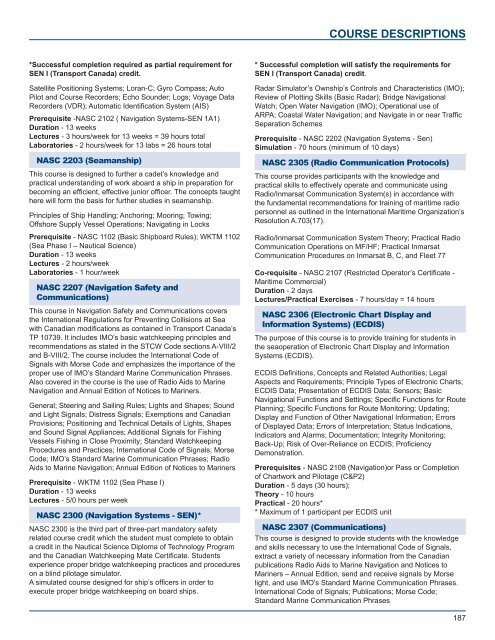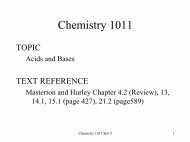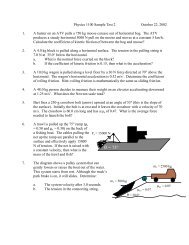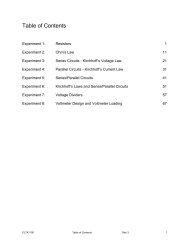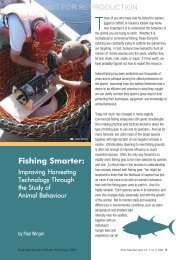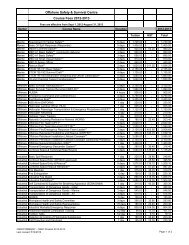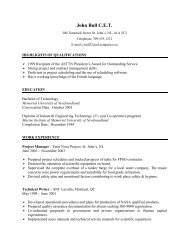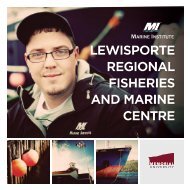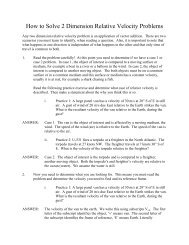Academic Calendar - Fisheries and Marine Institute - Memorial ...
Academic Calendar - Fisheries and Marine Institute - Memorial ...
Academic Calendar - Fisheries and Marine Institute - Memorial ...
You also want an ePaper? Increase the reach of your titles
YUMPU automatically turns print PDFs into web optimized ePapers that Google loves.
COURSE DESCRIPTIONS<br />
*Successful completion required as partial requirement for<br />
SEN I (Transport Canada) credit.<br />
Satellite Positioning Systems; Loran-C; Gyro Compass; Auto<br />
Pilot <strong>and</strong> Course Recorders; Echo Sounder; Logs; Voyage Data<br />
Recorders (VDR); Automatic Identification System (AIS)<br />
Prerequisite -NASC 2102 ( Navigation Systems-SEN 1A1)<br />
Duration - 13 weeks<br />
Lectures - 3 hours/week for 13 weeks = 39 hours total<br />
Laboratories - 2 hours/week for 13 labs = 26 hours total<br />
NASC 2203 (Seamanship)<br />
This course is designed to further a cadet’s knowledge <strong>and</strong><br />
practical underst<strong>and</strong>ing of work aboard a ship in preparation for<br />
becoming an efficient, effective junior officer. The concepts taught<br />
here will form the basis for further studies in seamanship.<br />
Principles of Ship H<strong>and</strong>ling; Anchoring; Mooring; Towing;<br />
Offshore Supply Vessel Operations; Navigating in Locks<br />
Prerequisite - NASC 1102 (Basic Shipboard Rules); WKTM 1102<br />
(Sea Phase I – Nautical Science)<br />
Duration - 13 weeks<br />
Lectures - 2 hours/week<br />
Laboratories - 1 hour/week<br />
NASC 2207 (Navigation Safety <strong>and</strong><br />
Communications)<br />
This course in Navigation Safety <strong>and</strong> Communications covers<br />
the International Regulations for Preventing Collisions at Sea<br />
with Canadian modifications as contained in Transport Canada’s<br />
TP 10739. It includes IMO’s basic watchkeeping principles <strong>and</strong><br />
recommendations as stated in the STCW Code sections A-VIII/2<br />
<strong>and</strong> B-VIII/2. The course includes the International Code of<br />
Signals with Morse Code <strong>and</strong> emphasizes the importance of the<br />
proper use of IMO’s St<strong>and</strong>ard <strong>Marine</strong> Communication Phrases.<br />
Also covered in the course is the use of Radio Aids to <strong>Marine</strong><br />
Navigation <strong>and</strong> Annual Edition of Notices to <strong>Marine</strong>rs.<br />
General; Steering <strong>and</strong> Sailing Rules; Lights <strong>and</strong> Shapes; Sound<br />
<strong>and</strong> Light Signals; Distress Signals; Exemptions <strong>and</strong> Canadian<br />
Provisions; Positioning <strong>and</strong> Technical Details of Lights, Shapes<br />
<strong>and</strong> Sound Signal Appliances; Additional Signals for Fishing<br />
Vessels Fishing in Close Proximity; St<strong>and</strong>ard Watchkeeping<br />
Procedures <strong>and</strong> Practices; International Code of Signals; Morse<br />
Code; IMO’s St<strong>and</strong>ard <strong>Marine</strong> Communication Phrases; Radio<br />
Aids to <strong>Marine</strong> Navigation; Annual Edition of Notices to <strong>Marine</strong>rs<br />
Prerequisite - WKTM 1102 (Sea Phase I)<br />
Duration - 13 weeks<br />
Lectures - 5/0 hours per week<br />
NASC 2300 (Navigation Systems - SEN)*<br />
NASC 2300 is the third part of three-part m<strong>and</strong>atory safety<br />
related course credit which the student must complete to obtain<br />
a credit in the Nautical Science Diploma of Technology Program<br />
<strong>and</strong> the Canadian Watchkeeping Mate Certificate. Students<br />
experience proper bridge watchkeeping practices <strong>and</strong> procedures<br />
on a blind pilotage simulator.<br />
A simulated course designed for ship’s officers in order to<br />
execute proper bridge watchkeeping on board ships.<br />
* Successful completion will satisfy the requirements for<br />
SEN I (Transport Canada) credit.<br />
Radar Simulator’s Ownship’s Controls <strong>and</strong> Characteristics (IMO);<br />
Review of Plotting Skills (Basic Radar); Bridge Navigational<br />
Watch; Open Water Navigation (IMO); Operational use of<br />
ARPA; Coastal Water Navigation; <strong>and</strong> Navigate in or near Traffic<br />
Separation Schemes<br />
Prerequisite - NASC 2202 (Navigation Systems - Sen)<br />
Simulation - 70 hours (minimum of 10 days)<br />
NASC 2305 (Radio Communication Protocols)<br />
This course provides participants with the knowledge <strong>and</strong><br />
practical skills to effectively operate <strong>and</strong> communicate using<br />
Radio/Inmarsat Communication System(s) in accordance with<br />
the fundamental recommendations for training of maritime radio<br />
personnel as outlined in the International Maritime Organization’s<br />
Resolution A.703(17).<br />
Radio/Inmarsat Communication System Theory; Practical Radio<br />
Communication Operations on MF/HF; Practical Inmarsat<br />
Communication Procedures on Inmarsat B, C, <strong>and</strong> Fleet 77<br />
Co-requisite - NASC 2107 (Restricted Operator’s Certificate -<br />
Maritime Commercial)<br />
Duration - 2 days<br />
Lectures/Practical Exercises - 7 hours/day = 14 hours<br />
NASC 2306 (Electronic Chart Display <strong>and</strong><br />
Information Systems) (ECDIS)<br />
The purpose of this course is to provide training for students in<br />
the seaoperation of Electronic Chart Display <strong>and</strong> Information<br />
Systems (ECDIS).<br />
ECDIS Definitions, Concepts <strong>and</strong> Related Authorities; Legal<br />
Aspects <strong>and</strong> Requirements; Principle Types of Electronic Charts;<br />
ECDIS Data; Presentation of ECDIS Data; Sensors; Basic<br />
Navigational Functions <strong>and</strong> Settings; Specific Functions for Route<br />
Planning; Specific Functions for Route Monitoring; Updating;<br />
Display <strong>and</strong> Function of Other Navigational Information; Errors<br />
of Displayed Data; Errors of Interpretation; Status Indications,<br />
Indicators <strong>and</strong> Alarms; Documentation; Integrity Monitoring;<br />
Back-Up; Risk of Over-Reliance on ECDIS; Proficiency<br />
Demonstration.<br />
Prerequisites - NASC 2108 (Navigation)or Pass or Completion<br />
of Chartwork <strong>and</strong> Pilotage (C&P2)<br />
Duration - 5 days (30 hours);<br />
Theory - 10 hours<br />
Practical - 20 hours*<br />
* Maximum of 1 participant per ECDIS unit<br />
NASC 2307 (Communications)<br />
This course is designed to provide students with the knowledge<br />
<strong>and</strong> skills necessary to use the International Code of Signals,<br />
extract a variety of necessary information from the Canadian<br />
publications Radio Aids to <strong>Marine</strong> Navigation <strong>and</strong> Notices to<br />
<strong>Marine</strong>rs – Annual Edition, send <strong>and</strong> receive signals by Morse<br />
light, <strong>and</strong> use IMO’s St<strong>and</strong>ard <strong>Marine</strong> Communication Phrases.<br />
International Code of Signals; Publications; Morse Code;<br />
St<strong>and</strong>ard <strong>Marine</strong> Communication Phrases<br />
187


